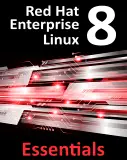A Brief History of Red Hat Linux
| Previous | Table of Contents | Next |
| About RHEL 6 Essentials | Installing RHEL 6 on a Clean Disk Drive |
|
You are reading a sample chapter from the RHEL 6 Edition book. Purchase the fully updated Red Hat Enterprise Linux 8 (RHEL 8) Edition of this publication in eBook ($9.99) or Print ($36.99) format Red Hat Enterprise Linux 8 Essentials Print and eBook (ePub/PDF/Kindle) editions contain 31 chapters and over 250 pages |
Red Hat Enterprise Linux is the product of a U.S. company called Red Hat, Inc., based in Raleigh, North Carolina near the campus of NC State University. The company was founded in the mid 1990s when Marc Ewing and Bob Young merged two companies.
In 1993 Bob Young created a company called ACC Corporation that he says he ran from his wife’s “sewing closet”. The name ACC was intended to represent a catalog business but was also an abbreviation of a small business his wife ran called Antiques and Collectables of Connecticut. Amongst the items sold through the ACC catalog business were Linux CDs and related open source software.
Around the same time Marc Ewing had created his own Linux distribution which he named Red Hat Linux (after his propensity to wear a red hat).
In 1995, ACC acquired Red Hat and adopted the name Red Hat, Inc. Red Hat went public in 1999 making both owners fabulously wealthy.
Early releases of Red Hat Linux were shipped to customers on floppy disks and CDs (this, of course, predated the widespread availability of broadband internet connections). When users encountered problems with the software they could contact Red Hat only by email. In fact, Bob Young often jokes that this was effective in limiting support requests since by the time a customer realized they needed help, their computer was usually inoperative and therefore unavailable to be used to send an email message seeking assistance from Red Hat’s support team.
In later years Red Hat provided better levels of support tied to paid subscriptions (and you can now get phone support 24 hours a day).
Red Hat Enterprise Linux 6 is the latest commercial offering from Red Hat and is targeted at corporate, mission critical installations. It is an open source product in that you can download the source code free of charge and build the software yourself if you wish to do so (a task not to be undertaken lightly) but if you wish to download a pre-built binary version of the software you have to buy a maintenance subscription which also provides you with support and updates.
Red Hat also sponsors the Fedora Project. The goal of this project is to provide access to a free Linux operating system (in both source and binary distributions) in the form of Fedora Linux. Fedora also acts as a proving ground for new features that eventually are adopted into the Red Hat Enterprise Linux operating system family.
For users that cannot afford a Red Hat Enterprise Linux subscription, another option is provided in the form of the CentOS operating system. CentOS is a community driven project that takes the source code to Red Hat Enterprise Linux, removes the Red Hat branding and subscription requirements, compiles it and provides the distribution for download.
Bob Young left the company in 1999 and has since gone on to start Lulu, a company that provides self-publishing services to book authors.
|
You are reading a sample chapter from the RHEL 6 Edition book. Purchase the fully updated Red Hat Enterprise Linux 8 (RHEL 8) Edition of this publication in eBook ($9.99) or Print ($36.99) format Red Hat Enterprise Linux 8 Essentials Print and eBook (ePub/PDF/Kindle) editions contain 31 chapters and over 250 pages |
| Previous | Table of Contents | Next |
| About RHEL 6 Essentials | Installing RHEL 6 on a Clean Disk Drive |





